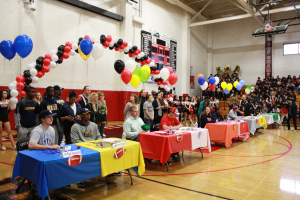
Fall is upon us, the sounds of summer have faded. For many players and coaches, the summer was full of days at ball fields across the country. For coaches the evaluation period is not over, but a transition is being made from evaluating prospective student athletes to solidifying commitments for their future rosters.
In the process of recruiting, the timeline has many different phases. One of the most important phases of the recruiting process is the “signing period.” In this phase of the process prospective student-athletes are able to sign their National Letter(s) of Intent. This is the end goal for the recruiting process as a student-athlete enters into an agreement with an academic institution. The National Letter of Intent website describes this agreement as follows:
“The NLI is a binding agreement between a prospective student-athlete and an NLI member institution
- A prospective student-athlete agrees to attend the institution full-time for one academic year (two semesters or three quarters).
- The institution agrees to provide athletics financial aid for one academic year (two semesters or three quarters).”
For baseball, there are two signing periods throughout the calendar year. The ‘early’ signing period for high school seniors is November 11-18, 2015. The regular signing period for high school seniors is April 13-August 1, 2016.
With the early signing period approaching this fall, it is an appropriate time to take a look at the ebb and flow of the recruiting process today.
As recruiting has grown into a year-round effort with the emergence of showcase baseball as well as high-level travel baseball, college commitments are happening earlier than ever before. With an understanding of the National Letter of Intent, it begs the question: are commitments made before the early signing period binding?
According to the National Letter of Intent website, the answer is no.
“A verbal commitment, stating publicly one's intentions to attend a certain institution, is a non-binding, oral agreement between the athlete and the institution. The only binding nature of the commitment is your word and the institution's promise. The NLI program does not recognize verbal commitments. It is not uncommon for a student to verbally commit to one institution and subsequently sign an NLI with another institution. And, on some occasions, a school may accept a verbal commitment and later offer the NLI to another prospective student-athlete.”
With interpretation of rules, there are positives and negatives to every policy. When it comes to the ever-evolving process of recruiting student-athletes today, the following come to mind:
Positives
- Consider All Angles: By extending the recruiting process and making it a longer experience, coaching staffs and prospective student-athletes are afforded the opportunity to take their time to mutually evaluate whether the agreement will be a good fit for both the student-athlete and the institution’s athletic program.
- A Time To Be Recognized: For some, the recruiting process is a once in a lifetime opportunity to be recognized for their talents and abilities. When a student-athlete lives a focused lifestyle for many years, this recognition can be an extrinsic motivator.
Negatives
- Pressure on student-athletes to commit early: With the accelerated experience of recruiting, there can be pressure on athletes to rush to make a decision quickly or be passed over for another athlete.
- Larger than life personalities: With all of the recognition and notoriety flooding ‘blue chip’ recruits, there can be a sense of entitlement that develops. This does not help the student-athlete adjust well to the college level of play or program they are joining.
- Change of heart: When it comes to verbal agreements, the process is far from over. After making a verbal commitment, the student-athlete may choose to take an offer from a different school. Also a coaching staff may choose to rescind their offer and give the opportunity to a different player. With this process, a verbal commitment carries less weight, and it is possible for a student-athlete to “commit” to multiple schools, before signing on the line during the early signing period or regular signing period.